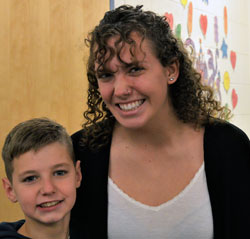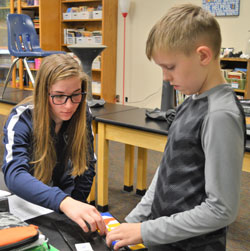Courtney Mulder spends an hour four days a week in special education teacher Lynelle Geers’ classroom at Appleview Elementary, where she works with individual students and helping with classroom activities.
This is the third time that she has been a teacher cadet, through a program at Sparta High School. The course has helped her learn what it’s like to lead a classroom over the past three semesters.
And, she said, her interest in becoming a teacher has increased.
“I have learned so much from being in Mrs. Geers’s classroom. She and her teaching assistants have allowed me to work hands-on and grow in my learning and how to handle a variety of different situations,” said Courtney. “I have gained an abundance of different skills that I will for sure use throughout my future.”
Related: Academy aims to groom future teachers for GRPS

The basics
The Sparta teacher cadet class, technically Experiential Learning, has been in place for many years, according to Blake Schanski, the high school counselor who oversees the program. The school offers two sections of the class to accommodate about 50 students who choose to take it each semester.
The class meets at the high school one day each week to discuss how to plan effective lessons, improve communication skills, practice presentations and discuss topics such as employability, said Schanski. Teacher cadets are placed in all district buildings from early elementary through high school for the remaining four days each week to assist teachers, help with classroom activities and work directly with students.
“We expect them to take an active or leadership role, not just grade papers or do busy work for the teacher,” said Schanski. “Often they take a few students at a time out of the classroom to help with academic studies.”

Cadet to classroom teacher?
The teacher cadet course is popular, but might not translate into a flood of new teachers. While some students, like Courtney, consider the program a possible stepping stone to an education career, that isn’t true for all.
“Everyone I know wants to take this class; it is in high demand,” said senior AJ Beck. “I don’t know how many are planning to teach, but they want to take it.”
AJ has her sights firmly set on becoming a physical therapist. “In physical therapy you also need to teach (patients) so I figured I could learn how to find ways to do that.”
“I plan to go to medical school and want to become a family doctor,” said senior Alec Rees, “and I thought it would be good for me to get experience working closely with children.”
Senior McKenna Dore said of a pursuing a teaching career: “probably not, but I like working with kids, so this was a good class to take.”
Senior Lilly Anderson said she hasn’t decided on a career path yet, but “wants to do something with children.”
AJ had a possible explanation. “I don’t know many who plan to teach –you know – because of the salary.”
Even Courtney has doubts. This year she is serving as a cadet in a special education classroom and her latest experiences have helped her realize “a strong desire to work with kids with special needs.” She is refocusing her career path.
“As of now, I am planning on getting a degree in social work to work with those with disabilities when they are in the hospital. Yet, being a special needs teacher is not completely out of the picture,” she said.

Valuable takeaways
Even students who aren’t planning to pursue education as a career can benefit from developing people skills and learning to deal with young people, Schanski said.
The cadets agreed.
AJ said she appreciates the skills she is learning while at the middle school, where she works individually with students in the Study Skills classroom. “I am learning to listen and communicate better,” she said.
“I wanted more experience working with children to make sure it was something that I would want to do,” said Lilly.
“I needed to learn how to communicate with little kids to be an effective family doctor,” said Alec.















